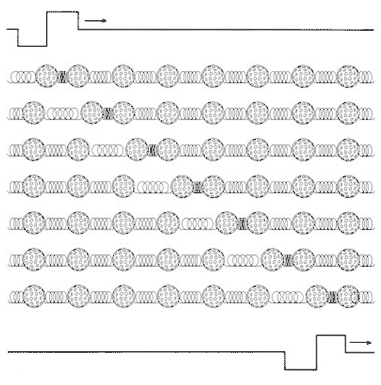Acoustics and Psychoacoustics.
David Howard and Jamie.
переведенная статья
1.1 PRESSURE WAVES AND SOUND TRANSMISSION
At a physical level sound is simply a mechanical disturbance of the medium, which may be air, or a solid, liquid or other gas. However, such a simplistic description is not very useful as it provides no information about the way this disturbance travels, or any of its characteristics other than the requirement for a medium in order for it to propagate. What is required is a more accurate description which can be used to make predictions of the behaviour of sound in a variety of contexts.
1.1.1 The nature of sound waves
Consider the simple mechanical model of the propagation of sound through some physical medium. This shows a simple one-dimensional model of a physical medium, such as air, which we call the golf ball and spring model because it consists of a series of masses, e.g. golf balls, connected together by springs. The golf balls represent the point masses of the molecules in a real material, and the springs represent the intermolecular forces between them. If the golf ball at the end is pushed toward the others then the spring linking it to the next golf ball will be compressed and will push at the next golf ball in the line which will compress the next spring, and so on. Because of the mass of the golf balls there will be a time lag before they start moving from the action of the connecting springs. This means that the disturbance caused by moving the first golf ball will take some time to travel down to the other end. If the golf ball at the beginning is returned to its original position the whole process just described will happen again, except that the golf balls will be pulled rather than pushed and the connecting springs will have to expand rather than compress. At the end of all this the system will end up with the golf balls having the same average spacing that they had before they were pushed and pulled. The region where the golf balls are pushed together is known as a compression whereas the region where they are pulled apart is known as a rarefaction, and the golf balls themselves are the propagating medium. In a real propagating medium, such as air, a disturbance would naturally consist of either a compression followed by a rarefaction or a rarefaction followed by a compression in order to allow the medium to return to its normal state. A picture of what happens is shown in Figure 1.2. Because of the way the disturbance moves - the golf balls are pushed and pulled in the direction of the disturbance's travel - this type of propagation is known as a longitudinal wave. Sound waves are therefore longitudinal waves which propagate via a series of compressions and rarefactions in a medium, usually air. There is an alternative way that a disturbance could be propagated down the golf ball and spring system. If, instead of being pushed and pulled toward each other, the golf balls were moved from side to side then a lateral disturbance would be propagated, due to the forces exerted by the springs on the golf balls as described earlier. This type of wave is known as a transverse wave and is often found in the vibrations of parts of musical instruments, such as strings or membranes.
